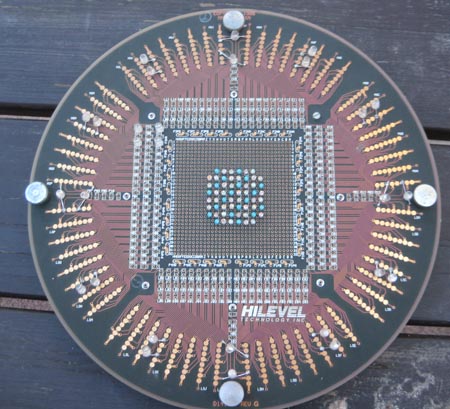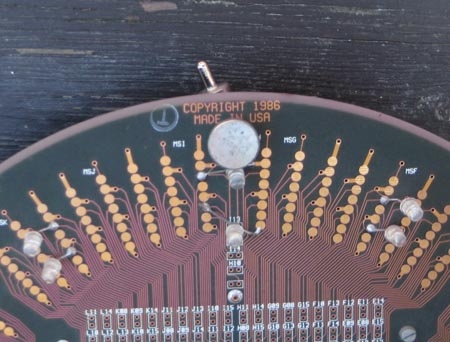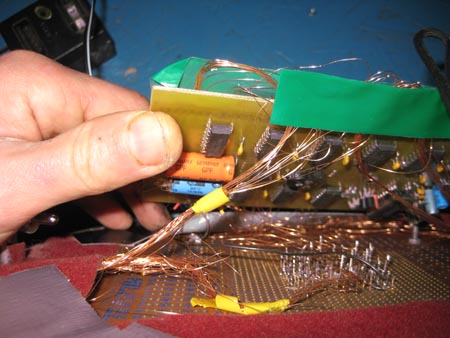|
|
|
crazy clock
Friday, February 13 2009
Today I finally turned my attention to fixing the bizarre digitalized analog clock that Susan the German translator dropped off for me to fix the other day. The clock's "brain" features the discrete macroscopic logic chips I remember from my teenage years back in the mid-1980s. As for the radially-symmetrical board hosting its array of 88 LEDs, it lays claim to a copyright date in 1986. Strangely, though, twenty of its LEDs produce a blue color, yet the blue LED wasn't available for consumer electronics until the late 1990s (indeed, the overbright blue LED only just stopped being ubiquitous in new electronics as a signal of "currentness"). It's difficult to determine whether the clock is a one-off homebrew prototype or based on a kit. It's possible that the main circuit board (the one hosting the digital logic chips) is from a kit, since it features a well-developed printed circuit, eleven CD4094BE eight bit shift registers, a PCF8573 Real Time Clock chip and an 87C751 microcontroller. The board hosting the LEDs seemed less single-purpose, with options for a much larger array than is being used in this implementation.
It turned out that the main things wrong with the clock were a few broken wires connecting the logic board with the LED board. The worst of these breaks was to a large wire whose absence disabled all but the sixty second-counting LEDs, though there were lesser breaks in two of the tiny bits of armature wire. All of these were easy to fix, and before long I had the clock running again. I should mention, by the way, that Susan had taken this clock to at least one electronics repair shop down in the City and it/they had refused the job.
After I was done fixing the problems, I threw in some additional fixes, such as moving the holder for the backup battery to the backside of the circuit board so the board wouldn't have to be removed (flexing all those dozens of lengths of armature wire) every time the battery was replaced (a huge design flaw). I also swapped out the precarious power supply, which consisted of a European wall wart and an adapter to American-style electrical outlets. [Later I would determine that the wall wart's output, which should have been 12 volts, was only six volts due to the level of American AC voltage. This six volts had been allowing the clock to operate, but only very unreliably. The only acceptable fix was a proper 12 volt power supply.]

The face of the crazy clock, photographed on the laboratory deck (which features 5.5 inch planks).

Though the clock was bought in Germany, its LED board was hecho en Estados Unidos.

The backside of the clock's logic board.

Those little armature wires connecting the logic board to the LED board.

The clock in operation, with most of the sixty seconds of a minute counted in the center.

The clock with only three seconds counted in the center. The clock counts through four minute units (in that cluster of red LEDs on the left) before advancing the minute hand, which is the ring of red LEDs on the outside. The ring of green LEDs count the hours. I love any device that reminds me of a Lite-Brite.
For linking purposes this article's URL is:
http://asecular.com/blog.php?090213 feedback
previous | next |





